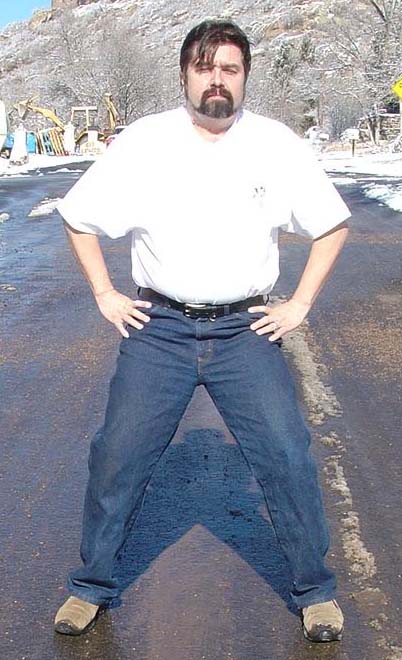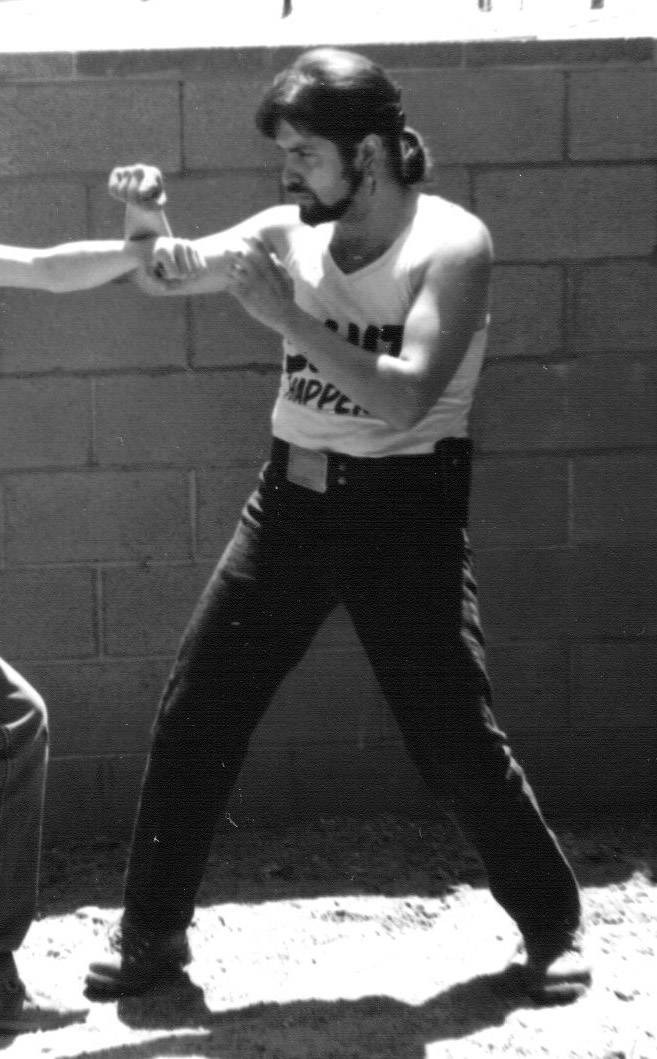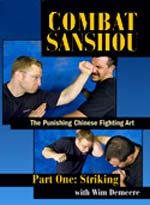Marc MacYoung?
Dianna Gordon MacYoung?
Animal E-list
Crime Avoidance Lectures
Crime Blog
Colorado Classes
Contact Us
FAQs
Hosting A Seminar
Crime Prevention
Expert Witness
Knife Defense
Law Enforcement
Martial Arts
Military
Movie Consulting
Women's Self-Defense
Links
Our Linking Policy
On-line Store
Train with MacYoung
Testimonials
Terms of Use
Topics
of Interest
Before you even think about
applying force to him
make sure that you have effectively dealt
with the force he is applying to you...
otherwise you'll never
get a chance to do your stuff. no matter how aggressive it is.
Dealing with Force
On this page:
I maintain that there are five basic situations where an officer will need to use physical force.
1). When a perp fights him.
2). When a individual is attempting to flee from being arrested
3). When a perp is assaulting someone else and the officer must pull that person
off another
4). When an individual is flailing about in an extreme emotional/chemical state
5). As a preemptive, control technique against an individual who is about to
become violent
Points one and two may often seem like the same thing. Because isn't someone who is trying to fight free of your hold trying to get away?
Well yes and no. We aren't just talking goals here ... we're also talking physics and force. Remember we said "flee" not "get away." The physics are different if you are clinched up with someone who is fighting against being put down than they are if you are hanging onto to someone's jacket as he tries to run from you. In the first case, he is intentionally putting force into you to get you off of him. In the second, the drag you are experiencing is a result from your connection to him. So one you're being pushed and one you're being pulled.
The fact is if you look at all of the scenarios we described you will see that each of them have different physics. The perp's body and your body will be moving in different ways in each. So you'll understand the differences, we'll use circles to indicate moving bodies, squares to indicate stationary bodies and arrows to indicate lines of force. We want you to realize these are extremely simplified versions to acquaint you with the different types of basic forces you will be dealing with.

Notice how each scenario involves different forces. In the fight the forces generated by each goes into the other.
In contrast, in trying to stop a fleeing suspect, the officer becomes an anchor that the suspect pulls against. The officer, like an anchor is most often stationary. (Another version of this is tackling a running suspect. But realistically how many of us can out run a fleeing teenager?)
In an assault, however, the officer pulling in a direction that is diametrically opposed to the direction of the perp's force
In closing with a flailing/out of control suspect the only clear force line is the one the officer generates. The perp's force is going in all different directions. If the officer does not overwhelm the perp immediately, the officer will become the focus of the perp's force.
In closing with a passive resister the officer is running into a stationary -- and often grounded -- mass. He must move the passive resister.
We point the different ways that forces occur for one main reason. And that
is even though you will be dealing with many different types of force in the
arrest and restraint of suspects, most officers really have only one way of
handling all these forces. And that is to take a wide legged stationary
stance. The problem with taking this stance is -- that while it is very stable --
you can't move in it. And if you can't move, then you can't
generate force.
The problem with taking this stance is -- that while it is very stable --
you can't move in it. And if you can't move, then you can't
generate force.
And now the really bad news, when you're standing this way, you're also a sitting duck for any force he wants to deliver into you.
It is critical to understand that when "receiving force" (or even facing the threat of force) taking this stance seems to be almost instinctive ... at least to most men. There are exceptions, but generally this stance seems to be an unconscious "default response" that men fall into. When you watch videos of officers attempting to subdue a suspect, you will see this stance deployed again and again -- often just before the violence peaks and/or the officer and the perp fall over together.
Upon seeing this photo most officers will swear on a stack of bibles that they would never stand like this in a conflict. Well, they're half right. We showed you a horse stance to show you the position of the legs. But next time you see an officer being dragged by a fleeing suspect, take a look at the stance he's in. It's often is basic pose except with the officer's knees bent, shoulders forward and butt thrust out back as a counterbalance to keep from getting pulled over.
Realistically you will see most officers in a stance where their feet are
turned as is their upper body. Functionally speaking,
 they've
just modified the basic stance. They're just as rooted and unable to move as
the full horse stance.
they've
just modified the basic stance. They're just as rooted and unable to move as
the full horse stance.
However, when you ask them about it later, most will insist that they were moving! This despite what the video clearly shows.
We cannot stress enough the importance of realizing that this is an unconscious move. Most people do not realize that they are doing it. We speculate that the reason this is the case is that it is a natural part of using muscle. So natural in fact, that like your breathing, until someone mentions it you don't even notice it. So let's look at what is involved in using your muscles, so you can begin to recognize when you are taking this stance.
In order to use the force generated by your muscles you must have a "base" to push off against. Think about weight lifting, if you do not have a base to create leverage off of, you cannot move the weight. All weight lifting exercises involve establishing at least one stable base to work the muscle. The base can be mechanical, (such as a bench or platform) or physiological (how you hold your body or stand), but one thing that all bases have in common is the earth. Whether it is a bench, seat, wall or free standing the foundation you are pushing off is the earth. Without this base to push against, you cannot generate force from your muscles. A good way of understanding this is you can take the strongest man in the world and put him floating in space and he would be helpless. There is no foundation for him to push off from.
We suspect that this stance is an unconscious action for both preparation for using muscle and using muscle to resist incoming force. It's what you do when you think muscle is needed.
In this pose, things are lined up so you can create force through your muscles. This is why we think it a preparatory move, one that is so natural that it has become lost in the process. It would be the equivalent of inhaling deeply before you hold your breath. But unlike holding your breath, this preparatory bracing is so ingrained that we aren't even aware we are doing it anymore. Many of us just automatically drop into it every time we "think" we need muscle.
This is why we thing taking this stance is an unconscious action. We're bracing ourselves to push (or being pushed). Unfortunately, by taking this stance it not only becomes a self-fulfilling prophecy, but we're stuck in that spot.
This page to be continued about how easy it is to get pushed or pulled over while attempting to use muscle. Because in order to use muscle you need to take this stance. That not only renders your defensive tactics ineffective, but it leaves you vulnerable to being knocked over ... oh yeah, and it means you've got a fight on your hands instead of an easy takedown.



Far Beyond Defensive Tactics
Learn More >
Order Now!

Hand to Hand Combat for Police Officers
Learn More >
Order Now!

Fighting Dirty
Learn More >
Order Now!

Filipino Kuntao
Learn More >
Order Now!

Restraint and Control Strategies
Learn More >
Order Now!

Combat Sanshou: Striking
Learn More >
Order Now!
<

Fighting Footwork of Kuntao/Silat Volume 2
Learn More >
Order Now!

Escape Combatives
Special Bonus Feature
ESCAPE DRIVING
Learn More >
Order Now!

Ground Combatives for Police
Learn More >
Order Now!

High Risk Entry
Learn More >
Order Now!

CQB Clearing Tactics For First Responders/ Patrol Tactics for 911 Officer
Learn More >
Order Now!

Hand to Hand Combat for Police Officers
Learn More >
Order Now!
| About navigating this site | Animal List | Bibliography | Bullies | Burglary while on vacation | Classes in Colorado | Car Jacking | Children and Martial Arts | Child Safety | Criminal Mindset | Cults in MA/SD | De-Escalation | E-mail Dianna | E-mail Marc| FAQs | Have MacYoung speak about crime avoidance | Home Page | Home Defense | Hosting a Seminar | Fear | Five Stages of Crime | Knife Fighting | Legal Issues | LEO/Correctional Officer/EMS | Linking policy | Links | Martial Arts | Photo Gallery | Property Crime | Psychology | Rape | Robbery | Safe Dating | Self-Defense Training | Selling your books/DVDs on NNSD | Seminar Schedule | Stalking/Domestic Violence | Street Fighting | Terms of Use | Testimonials | Train with Marc MacYoung | Who is Dianna Gordon MacYoung? | Who is Marc "Animal" MacYoung? | Victimhood | Workplace Problems | Zero Tolerance | ||
| ? 1998-2008 No Nonsense Self-Defense, LLC. All rights reserved. |